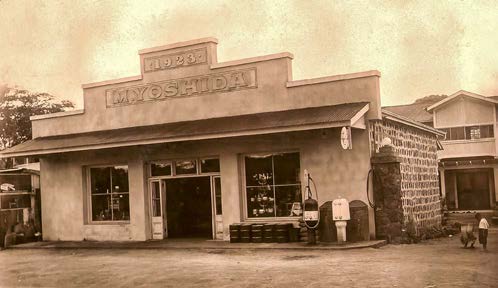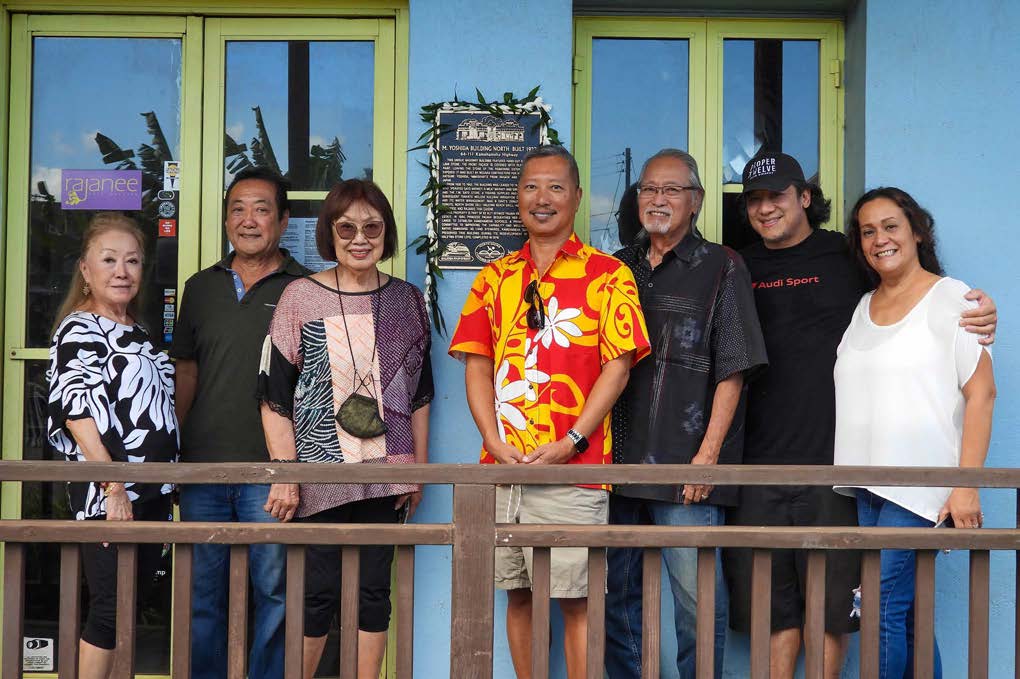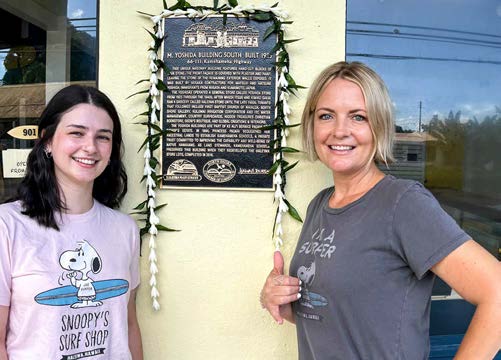
M.Yoshida Building (North) with the Yoshida family descendants Rania Hee, Steven Kawamura, Jean Kawamura, Keleawe Hee, Dennis Miyahara and Rajanee Thai Cuisine owners Kenny Usamanont and Michelle Maldonado. Photo: Hale'iwa Store Lots.
Submitted by the North Shore Chamber of Commerce’s Historic Preservation Committee; working to preserve and perpetuate the legacy of historic Hale‘iwa. Reprinted with permission.
The North Shore Chamber of Commerce, as part of its mission of historic preservation of significant sites in Hale‘iwa, installed two bronze plaques commemorating the Yoshida buildings in October 2023. Similar to eighteen other plaques that can now be found throughout Hale‘iwa, the plaque language depicts the architectural and entrepreneurial history of the buildings.
The M. Yoshida Buildings, 1923-2024
Often described as buildings made of cubes of sugar stone, the Yoshida Buildings in Hale‘iwa were actually constructed with hand cut blocks of lava rock. The façade of each building was covered with plaster and paint while the exterior stone walls were left exposed. The unique “sugar cube” appearance of the buildings’ exterior has changed little since they were constructed by Nosaka Contractors for Matsuji and Hatsune Yoshida in 1923.
Matsuji, a first-generation Issei, arrived in Hawai‘i from Niigata in 1902 and was believed to have worked for the Waialua Sugar Plantation. In 1910 he married Hatsune Takaki, also a first-generation Issei, who came to Hawai‘i from Kumamoto Japan in 1907. They raised three daughters, Ayako, Kikuyo and Sumie in their family residence behind the Yoshida Buildings. By 1916 the Yoshidas were running a general store in a single-story wood frame building on the property. The twin buildings were completed several years later, proclaiming the M. Yoshida name.
The Yoshida Store opened in the South Building with imported Japanese merchandise, groceries, and dry goods for sale. When Matsuji died in 1944, his wife Hatsune operated the store with the help of her two younger daughters. It was demanding work for the young women who loaded heavy bags of rice and other goods on to the family truck for delivery to customers in Kawailoa and other nearby plantation camps. Hatsune continued to manage the store until the Sakai family took it over in the 1950s.
Itsuo and Kimiko Sakai opened the Hale‘iwa Store in the South Building after running a branch store of the K. Sakai Shoten in a pineapple plantation camp in Waimea. In July of 1957, Itsuo opened KITS Super Market in Hale‘iwa, a joint venture with Koichi Kato and Tadashi Haga, two other grocery merchants in the Hale‘iwa-Waialua area. Itsuo was the nephew of Kasaku Sakai who had established the K. Sakai Store in 1907 on the site that is now First Hawaiian Bank in Hale‘iwa. In 2007, Kasaku’s grandson Roy permanently closed the doors of the Hale‘iwa Super Market built by Roy’s uncle Mutsuyuki Charles Sakai in 1975. It was the end of the Sakai family business that had continued for a full century.
The First Baptist Church of Waialua was located in the South Building during the early sixties, followed by the North Shore Gallery until 1972 when Kuluwai Irrigation Company and ITC Water Management set up offices and shops in both the South and North Buildings. Manager Mike Farrell reported that the company designed and built much of the Waialua Sugar Plantation irrigation infrastructure. It was possibly the last business in the Yoshida buildings directly connected to the plantation era, but the history of Hale‘iwa will be forever linked to the dominating influence of the sugar industry.
Subsequent tenants in the South Building include Country Surfboards, Hidden Treasures Christian Bookstore, Deeni’s Boutique and Global Creations & Interiors. The current tenant, Snoopy’s Surf Shop, opened in the Yoshida South Building on January 7, 2022.
Matsuji Yoshida’s reason for the construction of separate North and South Buildings on leasehold property is unknown. While he and Hatsune operated the Yoshida Store in the South Building, the Miyaharas, relatives of the Yoshidas, ran a market in the North Building. When the Miyaharas relocated their market to nearby Takeyama Camp, Matsuji leased the space to Takehiko Michael Sato, a first-generation Issei from Kumamoto Prefecture. For more than thirty years, Sato Market in the North Building provided meat and groceries to the local community. Catering to the needs of local fishermen, some who likely ran one of the many sampan boats anchored along the banks of the Anahulu Stream, Sato also ran the T.M. Sato Store, a fishing supplies and bait store. He operated a taxi service with the help of his wife Misao, a second-generation Nisei who worked as a seamstress and provided laundry services for plantation bachelors. The Satos raised a family of five children in a home near the store.
By the mid-1970s, Mag n Dave’s Donuts occupied the space, followed by Country Donuts in the 1980s. The North Shore Deli and the Hale‘iwa Beach Grill were followed by Hale‘iwa Eats Thai Food. Located in the North Building since 2015, Rajanee Thai Cuisine offers a menu reminiscent of the childhood memories of Master Chef Rajanee. Such exotic cuisine so far removed from the plantation era, is an example of the cosmopolitan atmosphere of Hale‘iwa today. What a difference a century can make!
M. Yoshida Building North, Built 1923, 66-111 Kamehameha Highway
This unique masonry building features hand-cut blocks of lava stone. The front façade is covered with plaster and paint leaving the stone of the remaining exterior walls exposed. It was built by Nosaka Contractors for Matsuji and Hatsune Yoshida, immigrants from Niigata and Kumamoto, Japan.
From 1930 to 1962, the building was leased to Takehiko Sato who operated Sato Market, a meat market and grocery store, and the T.M. Sato Store, a fishing supplies and bait store. Subsequent tenants include Kuluwai Irrigation Corporation and ITC Water Management, Mag n Dave’s Donuts, Country Donuts, North Shore Deli, Hale‘iwa Beach Grill, Hale‘iwa Eats Thai Food, and Rajanee Thai Cuisine.
This property is part of Ke Ali‘i Bernice Pauahi Pākī Bishop’s estate. In 1884, Princess Pauahi bequeathed her ancestral lands to establish Kamehameha Schools, a private trust committed to improving the capability and well-being of Native Hawaiians. As land stewards, Kamehameha Schools preserved this building during its redevelopment of the Hale‘iwa Store Lots, completed in 2016. (Plaque Language)
This article was co-authored by Laura Figueira and Barbara Ritchie, members of the Historic Preservation Committee of the North Shore Chamber of Commerce.








